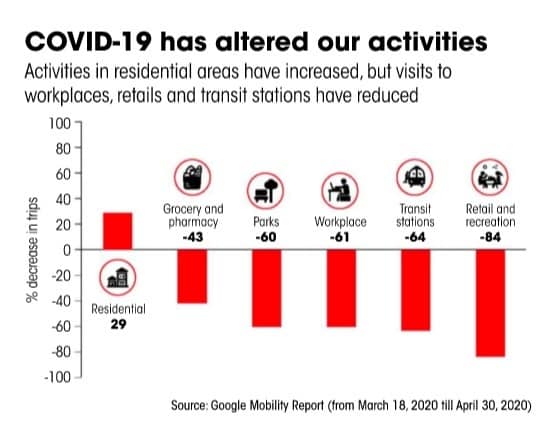Mobility redefined
Down To Earth
|July 16, 2020
The pandemic offers probably the last chance to reform our public transport and make way for walking and cycling
-

FEAR OF infection and the need for social distancing have altered the way we used to move around just a few months ago—in the pre-COVID times. Since then our activity and mobility patterns have changed dramatically, so much so that it has led to a near-collapse of the public transport in cities.
CSE’s analysis of Google Mobility Data for the period between February 15 and May 16 shows that activities in residential areas have increased by 29 per cent but visits to workplaces have reduced by 60 per cent and to retail and recreation by 84 per cent. Grocery and pharmacy visits also indicate a drop, though marginal. (see 'COVID-19 has altered our activities').
The data also shows a massive drop in visits to transit stops and nodes as the use of public transport has plummeted across the country. COVID-19, it seems, has stigmatised the public transport. And this has provoked more worries. Since opening up of the economy is not possible without transport, the fear is it might lead to an increase in the number of cars and two-wheelers on the roads, making the cities even more congested and polluted.
Clearly, there is an urgent need to organise mobility services. Here are a few steps that can help the authorities do this in a prudent manner.

REINVENT PUBLIC TRANSPORT Public transport ridership came to a halt due to complete lockdown in India. Other countries that did not impose a lockdown and kept their public transport functional have also faced drastic reduction in ridership—by as much as 70 to 90 per cent. This calls for an urgent need to rebuild confidence in the public transport.
Cette histoire est tirée de l'édition July 16, 2020 de Down To Earth.
Abonnez-vous à Magzter GOLD pour accéder à des milliers d'histoires premium sélectionnées et à plus de 9 000 magazines et journaux.
Déjà abonné ? Se connecter
PLUS D'HISTOIRES DE Down To Earth

Down To Earth
KING OF BIRDS
Revered for centuries, western tragopan now needs protection as its forests shrink, human pressures mount
3 mins
December 16, 2025

Down To Earth
WHISKERS ALL AQUIVER
Climate change threatens creatures that have weathered extreme environments for thousands of years
2 mins
December 16, 2025

Down To Earth
GOLDEN SPIRIT
Survival of the shy primate is closely tied to the health of Western Ghats
3 mins
December 16, 2025

Down To Earth
RINGED EYES IN THE CANOPY
Rapid habitat destruction forces arboreal langur to alter habits
2 mins
December 16, 2025

Down To Earth
HANGING BY THE CLIFF
The Himalaya's rarest wild goat is on the brink of local extinction
2 mins
December 16, 2025

Down To Earth
ANGEL OF THE BEAS
Conservation reserves, citizen science, and habitat protection give the Indus River dolphin a fighting chance in India
2 mins
December 16, 2025

Down To Earth
UNDER MOONLIT SCRUB
Survival of this hidden guardian tells us whether our scrublands still breathe
2 mins
December 16, 2025

Down To Earth
SYMBOL OF SILENT VALLEY
Lion-tailed macaque remains vulnerable despite past victories
2 mins
December 16, 2025

Down To Earth
THE APE IN OUR STORIES
India's only non-human ape species is a cultural icon threatened by forest fragmentation
2 mins
December 16, 2025

Down To Earth
SENTINEL OF THE HIGH COLD DESERT
The bird's evocative call may not continue to roll across the cold desert valley for long
3 mins
December 16, 2025
Translate
Change font size

